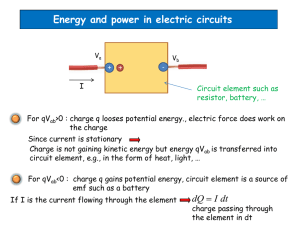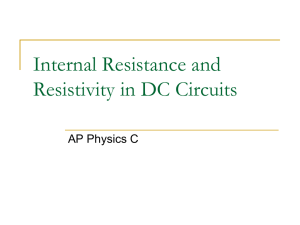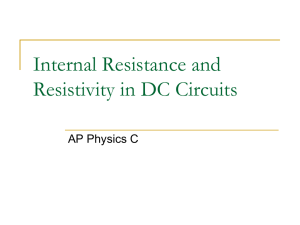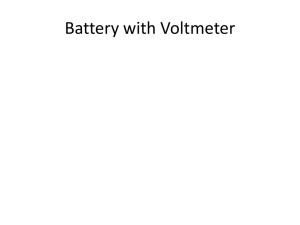resistance
advertisement
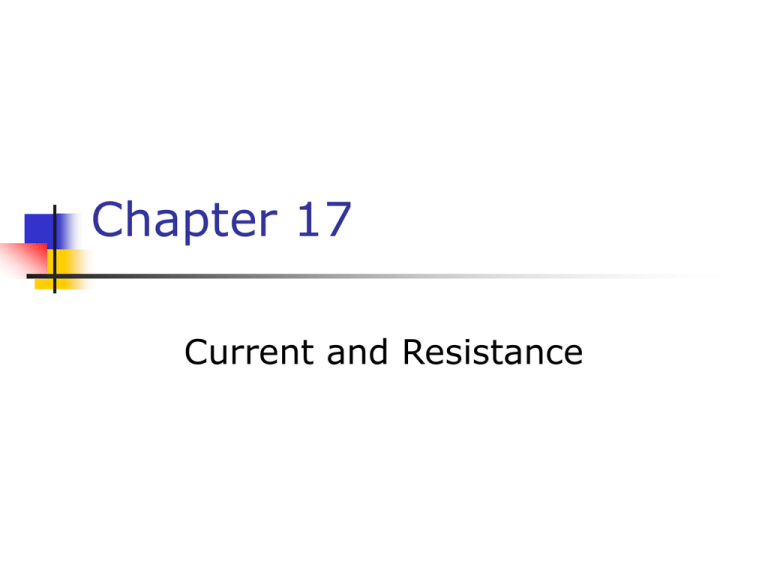
Chapter 17 Current and Resistance Electric Current Whenever electric charges of like signs move, an electric current is said to exist The current is the rate at which the charge flows through this surface Look at the charges flowing perpendicularly to a surface of area A Q I t The SI unit of current is Ampere (A) 1 A = 1 C/s Electric Current, cont The direction of the current is the direction positive charge would flow This is known as conventional current direction In a common conductor, such as copper, the current is due to the motion of the negatively charged electrons It is common to refer to a moving charge as a mobile charge carrier A charge carrier can be positive or negative Properties of a Current Definition of a Current Conservation of Current Iin Iout Checking Understanding Rank the bulbs in the following circuit according to their brightness, from brightest to dimmest. A. B. C. D. ABCD ABCD ADBC BCAD Answer Rank the bulbs in the following circuit according to their brightness, from brightest to dimmest. A. B. C. D. ABCD ABCD ADBC BCAD Meters in a Circuit – Ammeter An ammeter is used to measure current In line with the bulb, all the charge passing through the bulb also must pass through the meter Meters in a Circuit – Voltmeter A voltmeter is used to measure voltage (potential difference) Connects to the two ends of the bulb Resistance In a conductor, the voltage applied across the ends of the conductor is proportional to the current through the conductor The constant of proportionality is the resistance of the conductor V R I Resistance, cont Units of resistance are ohms (Ω) 1Ω=1V/A Resistance in a circuit arises due to collisions between the electrons carrying the current with the fixed atoms inside the conductor Georg Simon Ohm 1787 – 1854 Formulated the concept of resistance Discovered the proportionality between current and voltages Ohm’s Law Experiments show that for many materials, including most metals, the resistance remains constant over a wide range of applied voltages or currents This statement has become known as Ohm’s Law ΔV = I R Ohm’s Law is an empirical relationship that is valid only for certain materials Materials that obey Ohm’s Law are said to be ohmic Ohm’s Law, cont An ohmic device The resistance is constant over a wide range of voltages The relationship between current and voltage is linear The slope is related to the resistance Ohm’s Law, final Non-ohmic materials are those whose resistance changes with voltage or current The current-voltage relationship is nonlinear A diode is a common example of a nonohmic device Reading Quiz 1. The charge carriers in metals are A. B. C. D. electrons. positrons. protons. a mix of protons and electrons. Answer 1. The charge carriers in metals are A. B. C. D. electrons. positrons. protons. a mix of protons and electrons. Slide 22-7 Reading Quiz 2. A battery is connected to a resistor. Increasing the resistance of the resistor will A. increase the current in the circuit. B. decrease the current in the circuit. C. not affect the current in the circuit. Answer 2. A battery is connected to a resistor. Increasing the resistance of the resistor will A. increase the current in the circuit. B. decrease the current in the circuit. C. not affect the current in the circuit. Reading Quiz 3. A battery is connected to a resistor. As charge flows, the chemical energy of the battery is dissipated as A. B. C. D. current. voltage. charge. thermal energy. Answer 3. A battery is connected to a resistor. As charge flows, the chemical energy of the battery is dissipated as A. B. C. D. current. voltage. charge. thermal energy. Resistivity The resistance of an ohmic conductor is proportional to its length, L, and inversely proportional to its crosssectional area, A L R A ρ is the constant of proportionality and is called the resistivity of the material See table 17.1 Resistivity The resistance of a wire depends on its dimensions and the resistivity of its material: Slide 22-22 Temperature Variation of Resistivity For most metals, resistivity increases with increasing temperature With a higher temperature, the metal’s constituent atoms vibrate with increasing amplitude The electrons find it more difficult to pass through the atoms Temperature Variation of Resistivity, cont For most metals, resistivity increases approximately linearly with temperature over a limited temperature range o [1 (T To )] ρ is the resistivity at some temperature T ρo is the resistivity at some reference temperature To To is usually taken to be 20° C is the temperature coefficient of resistivity Temperature Variation of Resistance Since the resistance of a conductor with uniform cross sectional area is proportional to the resistivity, you can find the effect of temperature on resistance R Ro [1 (T To )] Superconductors A class of materials and compounds whose resistances fall to virtually zero below a certain temperature, TC TC is called the critical temperature The graph is the same as a normal metal above TC, but suddenly drops to zero at TC Superconductors, cont The value of TC is sensitive to Chemical composition Pressure Crystalline structure Once a current is set up in a superconductor, it persists without any applied voltage Since R = 0 Superconductor, final Good conductors do not necessarily exhibit superconductivity One application is superconducting magnets Electrical Energy and Power In a circuit, as a charge moves through the battery, the electrical potential energy of the system is increased by ΔQΔV The chemical potential energy of the battery decreases by the same amount As the charge moves through a resistor, it loses this potential energy during collisions with atoms in the resistor The temperature of the resistor will increase Energy Transfer in the Circuit Consider the circuit shown Imagine a quantity of positive charge, Q, moving around the circuit from point A back to point A Energy Transfer in the Circuit, cont Point A is the reference point It is grounded and its potential is taken to be zero As the charge moves through the battery from A to B, the potential energy of the system increases by QV The chemical energy of the battery decreases by the same amount Energy Transfer in the Circuit, final As the charge moves through the resistor, from C to D, it loses energy in collisions with the atoms of the resistor The energy is transferred to internal energy When the charge returns to A, the net result is that some chemical energy of the battery has been delivered to the resistor and caused its temperature to rise Electrical Energy and Power, cont The rate at which the energy is lost is the power Q V I V t From Ohm’s Law, alternate forms of power are V I R R 2 2 Electrical Energy and Power, final The SI unit of power is Watt (W) I must be in Amperes, R in ohms and V in Volts The unit of energy used by electric companies is the kilowatt-hour This is defined in terms of the unit of power and the amount of time it is supplied 1 kWh = 3.60 x 106 J Checking Understanding The wires below carry currents as noted. Rate the currents IA, IB and IC: A. I A I B I C B. I B I A I C C. I C I A I B D. I A I C I B E. I C I B I A Answer The wires below carry currents as noted. Rate the currents IA, IB and IC: A. I A I B I C B. I B I A I C C. I C > I A > I B D. I A I C I B E. I C I B I A Batteries The potential difference between the terminals of a battery, often called the terminal voltage, is the battery’s emf. Wchem Vbat e q Simple Circuits The current is determined by the potential difference and the resistance of the wire: Vwire I R Checking Understanding A battery is connected to a wire, and makes a current in the wire. Which of the following changes would increase the current? (1) Increasing the length of the wire; (2) keeping the wire the same length, but making it thicker; (3) using a battery with a higher-rated voltage; (4) making the wire into a coil, but keeping its dimensions the same; (5) increasing the temperature of the wire. A. B. C. D. E. All of the above 1 and 5 1, 4, and 5 2 and 3 None of the above Answer A battery is connected to a wire, and makes a current in the wire. Which of the following changes would increase the current? (1) Increasing the length of the wire; (2) keeping the wire the same length, but making it thicker; (3) using a battery with a higher-rated voltage; (4) making the wire into a coil, but keeping its dimensions the same; (5) increasing the temperature of the wire. A. B. C. D. E. All of the above 1 and 5 1, 4, and 5 2 and 3 None of the above Checking Understanding: Measuring Light Intensity A battery is connected to a photoresistor. When light shines on this resistor, it increases the number of charge carriers that are free to move in the resistor. Now, the room lights are turned off, so less light falls on the photoresistor. How does this affect the current in the circuit? A. The current increases. B. The current decreases. C. The current is not affected. Answer A battery is connected to a photoresistor. When light shines on this resistor, it increases the number of charge carriers that are free to move in the resistor. Now, the room lights are turned off, so less light falls on the photoresistor. How does this affect the current in the circuit? A. The current increases. B. The current decreases. C. The current is not affected. Power in Circuits Energy and Power in Resistors Checking Understanding A resistor is connected to a 3.0 V battery; the power dissipated in the resistor is 1.0 W. The battery is traded for a 6.0 V battery. The power dissipated by the resistor is now A. B. C. D. 1.0 W 2.0 W 3.0 W 4.0 W Answer A resistor is connected to a 3.0 V battery; the power dissipated in the resistor is 1.0 W. The battery is traded for a 6.0 V battery. The power dissipated by the resistor is now A. B. C. D. 1.0 W 2.0 W 3.0 W 4.0 W Summary Additional Questions 1. A set of lightbulbs have different rated voltage and power, as in the table below. Which one has the highest resistance? Bulb A B C D E Rated voltage 10 V 8V 12 V 6V 3V Rated power 1W 1W 2W 2W 3W Answer 1. A set of lightbulbs have different rated voltage and power, as in the table below. Which one has the highest resistance? Bulb A B C D E Rated voltage 10 V 8V 12 V 6V 3V Rated power 1W 1W 2W 2W 3W Additional Questions 2. A set of lightbulbs have different rated voltage and power, as in the table below. Which one has lowest resistance? Bulb A B C D E Rated voltage 10 V 8V 12 V 6V 3V Rated power 1W 1W 2W 2W 3W Answer 2. A set of lightbulbs have different rated voltage and power, as in the table below. Which one has lowest resistance? Bulb A B C D E Rated voltage 10 V 8V 12 V 6V 3V Rated power 1W 1W 2W 2W 3W Additional Questions 3. A battery makes a circuit with a lightbulb as shown. Two compasses are near the wires before and after the bulb in the circuit. Which compass experiences a larger deflection? A. Compass 1 experiences a larger deflection. B. Compass 2 experiences a larger deflection. C. Both compasses experience the same deflection. Answer 3. A battery makes a circuit with a lightbulb as shown. Two compasses are near the wires before and after the bulb in the circuit. Which compass experiences a larger deflection? A. Compass 1 experiences a larger deflection. B. Compass 2 experiences a larger deflection. C. Both compasses experience the same deflection. Additional Questions 4. In Trial 1, a battery is connected to a single lightbulb and the brightness noted. Now, in Trial 2, a second, identical, lightbulb is added. How does the brightness of these two bulbs compare to the brightness of the single bulb in Trial 1? A. The brightness is greater. B. The brightness is the same. C. The brightness is less. Answer 4. In Trial 1, a battery is connected to a single lightbulb and the brightness noted. Now, in Trial 2, a second, identical, lightbulb is added. How does the brightness of these two bulbs compare to the brightness of the single bulb in Trial 1? A. The brightness is greater. B. The brightness is the same. C. The brightness is less. End of Chapter Problems 3, 12, 22, 28, 32, 35, 38, 39




